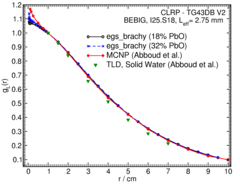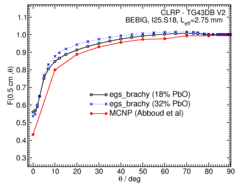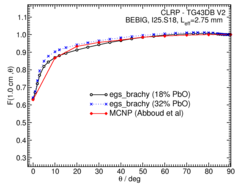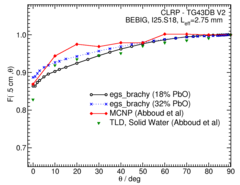
Source Description:
Dimensions for the I25.S18 source are taken from the study by Abboud et al 1. The I25.S18 source consists of a cylindrical radiopaque leaded galss (ρ = 4.88 g cm-1) marker 2.75 mm in length and 0.24 mm in radius, with a 0.023 mm thick quartz layer of Sio2 on its outer surface (ρ = 2.54 g cm-1) that contains a unoform distribution of ion-implanted xenon-124 atoms. In this study the marker is assumed to have minimum or maximum avilable Lead-glass (18% vs 32%). This layer subsequently coated with an addiational 0.002 mm thick quart layer (ρ = 2.21 g cm-1). The marker is encapulated in a biocompatible polymer layer (i.e, polyacryletheretherketone or PEEK, ρ = 1.32 g cm-1) with a length of 4.50 mm and outer diammeter of 0.78 mm. The encapsulation ends are formed into spherical "cups'' to permit stranding of the sources. The cups are 0.022 mm in radius and have their centers shifted 0.021 mm from the center of the source. The overall source length is 4.50 mm, and the active length is 2.75 mm. The mean photon energy calculated on the surface of the source is 28.17 keV and 28.12 keV for minimum ansd maximum avilable Lead-glass in source marker with statistical uncertainties < 0.015%.
(Note: With a minimum (18%) and maximum (32%) Lead-glass in marker, differences up to 7% were observed at angles < 20° for 2D anisotropy function, and up to 3% for radial dose functions at r <0.2 cm.)
Dose-Rate Constant - Λ :
Dose-rate constants, Λ , are calculated by dividing the dose to water per history in a (0.1 mm)3 voxel centered on the reference position, (1 cm,Π/2), in a 30x30x30 cm3 water phantom, by the air-kerma strength per history (scored in vacuo). As described in ref. 2, dose-rate constants are provided for air-kerma strength calculated using voxels of 2.66x2.66x0.05 cm3 (WAFAC) and 0.1x0.1x0.05 cm3 (point) located 10 cm from the source. The larger voxel size averages the air kerma per history over a region covering roughly the same solid angle subtended by the primary collimator of the WAFAC 3,4 at NIST used for calibrating low-energy brachytherapy sources and is likely the most clinically relevant value. The small voxel serves to estimate the air kerma per history at a point on the transverse axis and includes a small 1/r2 correction (0.5%)2. MC uncertainties are only statistical uncertainties (k=1).
| Author | Method | Λ (cGy h-1 U-1) | Abs. Uncertainty |
| Safigholi et al 5 | WAFAC + | 0.9072 | 0.0001 |
| Safigholi et al5 | point + | 0.9029 | 0.0014 |
| Safigholi et al 5 | WAFAC * | 0.8865 | 0.0018 |
| Safigholi et al 5 | point * | 0.8803 | 0.0015 |
| Abboud et al 1 | WAFAC (MCNP) | 0.905 | 0.027 |
| Abboud et al 1 | TLD (Solid water) | 0.885 | 0.059 |
| Rivard et al 6 | TG43U1S2 Consensus Value | 0.893 | ---- |
Radial dose function - g(r):
The radial dose function, g(r), is calculated using both line and point source geometry functions and tabulated at 36 different radial distances ranging from 0.1 cm to 10 cm. Fit parameters for a modified polynomial expression for 18% Lead-glass in source marker are also provided 7 . The mean residual deviations from the actual data for the best fit were < 0.07%.
Click image for higher res version| Fitting coefficients for g L (r) = (a0 r-2 + a1 r-1 + a2 + a3r + a4r2 + a5 r3) e-a6r | |||
| Fit range | Coefficients | ||
| r min (cm) | r max (cm) | ||
| 0.10 | 10.00 | a0 / cm2 | (-8.9+/-0.4)E-04 |
| a1 / cm | (1.15+/-0.05)E-02 | ||
| a2 | (1.0313+/-0.0016)E+00 | ||
| a3 / cm-1 | (4.82+/-0.07)E-01 | ||
| a4 / cm-2 | (-7.8+/-1.6)E-03 | ||
| a5 / cm-3 | (1.34+/-0.08)E-03 | ||
| a6 / cm-1 | (4.19+/-0.05)E-01 | ||
Anisotropy function - F(r,θ):
Anisotropy functions are calculated using the line source approximation and tabulated at radii of 0.1, 0.15, 0.25, 0.5, 0.75, 1, 2, 3, 4, 5, 7.5 and 10 cm and 32 unique polar angles with a minimum resolution of 5 o . The anisotropy factor, φ an (r), was calculated by integrating the solid angle weighted dose rate over 0 o ≤ ϑ ≤ 90 o .
References:
1. Abboud F, Hollows M, Scalliet P, Vynckier S. Experimental and theoretical dosimetry of a new polymer encapsulated iodine-125 source
smartseed: dosimetric impact of fluorescence x rays. Med. Phys., 37, 2054–2062, 2010.
2.R. E. P. Taylor et al, Benchmarking BrachyDose: voxel-based EGSnrc Monte Carlo calculations of TG--43 dosimetry parameters, Med. Phys., 34 , 445 - 457, 2007.
3. R. Loevinger, Wide-angle free-air chamber for calibration of low--energy brachytherapy sources, Med. Phys., 20 , 907, 1993.
4. S. M Seltzer et al, New National Air-Kerma-Strength Standards for 125I and 103Pd Brachytherapy Seeds, J. Res. Natl. Inst. Stand. Technol., 108 , 337 - 358, 2003.
5. H. Safigholi, M. J. P. Chamberland, R. E. P. Taylor, C. H. Allen, M. P. Martinov, D. W. O. Rogers, and R. M. Thomson, Updated of the CLRP TG-43 parameter database for low-energy photon-emitting brachytherapy sources, Med phys (2020).
6. M. J. Rivard et al, Supplement 2 for the 2004 update of the AAPM Task Group No. 43 Report: Joint recommendations by the AAPM and GEC-ESTRO , Med. Phys., 44 , e297 - e338, 2017.
7. R. E. P. Taylor, D. W. O. Rogers, More accurate fitting of 125I and 103Pd radial dose functions, Med. Phys., 35 , 4242-4250, 2008.



